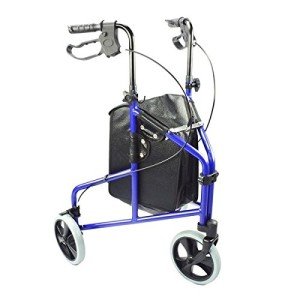
Rollator With Wheels
FollowOverview
-
Founded Date February 16, 1931
-
Sectors Charity & Voluntary
Company Description
Why People Don’t Care About Handicap Walker
Understanding Handicap Walkers: Types, Benefits, and Usage
Handicap walkers, also commonly called mobility walkers or simply walkers, serve as crucial aids for people with mobility challenges. These gadgets offer physical assistance and stability, allowing users to walk more confidently and independently. This article delves into the numerous types of handicap walkers, their benefits, and essential factors to consider when choosing one.
What is a Handicap Walker?
A handicap walker is a gadget designed to help individuals who have difficulty walking due to age, illness, or impairment. Walkers help users preserve their balance, prevent falls, and recover mobility. Unlike walking canes, which provide very little support, handicap walkers generally use a broader base of stability, making them appropriate for more significant mobility difficulties.

Types of Handicap Walkers
Handicap walkers been available in numerous designs, designed to meet the distinct requirements of users. Below is a breakdown of the most typical types:
| Type of Walker | Description | Perfect User |
|---|---|---|
| Standard Walker | A lightweight frame that requires raising to move. Generally has rubber pointers for traction. | Those who can lift the walker and have moderate balance problems. |
| Wheeled Walker | Features two wheels at the front, permitting for much easier mobility without lifting. | Users who can keep stability and need more support while walking. |
| Rollator Walker | Similar to wheeled walkers but includes hand brakes and a seat for resting. | Individuals requiring a portable resting choice with improved mobility. |
| Bariatric Walker | Particularly created for much heavier individuals, offering reinforced frames and bigger hand grips. | Heavier users needing extra assistance and stability. |
| Kid Walker | Customized designs for kids to aid in their development and mobility. | Children with developmental delays or mobility difficulties. |
Benefits of Using a Handicap Walker
Lots of users discover that handicap walkers considerably enhance their lifestyle. Here are some benefits:
1. Increased Stability
Handicap walkers offer a sturdy assistance structure, which assists avoid falls and enhances users’ self-confidence when moving.
2. Boosted Mobility
Walkers make it easier for individuals with mobility limitations to navigate stairs, uneven surface areas, and other tough environments.
3. Self-reliance
Using a walker makes it possible for individuals to perform everyday activities independently, whether it’s walking around the home or shopping.
4. Pain Relief
Walkers enhance posture and distribute weight more equally, potentially alleviating pain in joints and muscles during movement.
5. Social Engagement
By facilitating mobility, walkers permit users to get involved more actively in social occasions, household events, and neighborhood activities, promoting a sense of belonging.
Important Considerations When Choosing a Walker
Choosing the best handicap walker is essential for ensuring safety and convenience. Below are crucial elements to think about:
-
User’s Height: Walkers come in various heights. It’s necessary to select one that permits the user to stand upright with a small bend in the elbows when keeping the manages.
-
Weight Capacity: Assess the weight capacity of the walker, particularly for bariatric alternatives, to guarantee it fits the user’s requirements.
-
Portability: If the walker will be utilized regularly in numerous locations, think about models that can be quickly folded or carried, such as rollators.
-
Functions: Some walkers include extra functions like cushioned seats, storage baskets, and adjustable handles. Examine which features are most helpful for the user.
-
User Preferences: The person’s comfort and preferences ought to also play a substantial function in the selection. Testing numerous models may assist determine the very best fit.
How to Use a Handicap Walker Effectively
Using a handicap walker correctly makes sure safety and maximizes its benefits. Follow these steps for safe use:
- Adjust the Height: Make sure the walker is adapted to the correct height for the user.
- Stabilize the Walker: Place the walker in front while ensuring all four rubber ideas or wheels are in contact with the ground.
- Use Proper Techniques: Move the walker forward about one action length, and after that step into the walker while keeping the weight balanced.
- Keep Good Posture: Stand straight and make use of the walker for assistance, not leaning excessively on it.
- Practice Regularly: Encourage users to practice walking with the walker regularly, assisting to develop confidence and improve balance.
Frequently Asked Questions (FAQs)
1. What is the difference in between a standard walker and a rollator?
Requirement walkers require the user to raise them with each step, while rollators have wheels and enable the user to press them forward without lifting. Rollators also typically include brakes and may have a seat.
2. Are handicap walkers covered by insurance coverage?
Protection for handicap walkers can differ based on an individual’s insurance plan. It is advisable to contact the supplier for particular details relating to coverage and any necessary paperwork needed.
3. Can kids use handicap walkers?
Yes, there are walkers created particularly for children that accommodate their developmental needs. It’s vital to select a model that is age-appropriate and offers the essential support.
4. How do I keep my walker?
Routinely examine the walker for wear and tear, consisting of the grips and wheels. Tidy the walker as required and make sure all components are operating appropriately for safety.
5. When is it time to stop using a walker?
This differs by individual. Users must seek advice from their health care provider to examine mobility enhancements and discuss whether transitioning to a different mobility aid or moving without assistance is proper.
A handicap walker can be a transformative tool for individuals with mobility challenges, offering them higher stability, independence, and enhanced lifestyle. By understanding the numerous types, benefits, and key factors to consider in choosing a walker, people can make informed options that align with their unique requirements and lifestyle. Whether for rehab, aging gracefully, or handling impairments, handicap walkers play an important role in promoting mobility and well-being.

